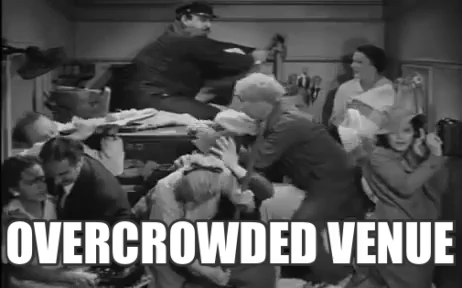Mistakes Associations Make — Part 2

1—Don’t contract your venue before designing your event!

Venue selection typically happens early in the event planning process—before budgeting, marketing, and F&B planning begin. But designing a thoughtful meeting process often gets overlooked or delayed, especially when the people convening the event aren’t familiar with participatory formats. So, they default to traditional workflows and bring me in post-contract, overlooking the need to think about how desired meeting outcomes might affect venue choice..
Meeting planners and venue staff are comfortable determining space needs for traditional events once they know:
- the type of event;
- the number of attendees; and
- the meeting duration.
But they rarely understand what’s required for participant-driven and participation-rich meetings, which typically need:
- larger general session rooms, to allow movement and eye contact; and
- more flexible and plentiful breakout spaces for small group interaction.
The result? About 95% of the time, the contracted venue requires compromises to accommodate interactive formats. Sometimes I can design around it. Sometimes the contract has to be renegotiated (cue planner shudder). And sometimes, the event just doesn’t deliver what it could have.
Avoid this entirely. Design the event first. Then choose your venue. You’ll save money and frustration, and ensure your space supports your goals.
2—Don’t call your event an “unconference” because it sounds cool!
Lately, I’ve noticed more event marketers using “unconference” to describe traditional conferences. Don’t do this. There’s a meaningful difference.
Here’s how Wikipedia defines an unconference:
“An unconference is a participant-driven meeting.”
“Typically at an unconference, the agenda is created by the attendees at the beginning of the meeting.”
—Unconference, Wikipedia
Sorry, folks, but that’s not what happens when you use pre-event surveys or curate the program in advance. That’s not an unconference—it’s a conference.
I have been convening and facilitating unconferences (I prefer the term peer conferences, but no one else cares) since 1992. Why? Because they provide a far better conference experience. They give attendees what they actually want in real time—something no program committee or conference “curator” can predict.
In 2010, I explained why asking attendees in advance for program suggestions doesn’t work. And a couple of years later, I shared why a program committee or the mythical “conference curator” doesn’t do any better:
“In my twenty years of organizing conferences, I’ve never found a program committee that predicted more than half of the session topics that conference attendees chose when they were given the choice. During that time I’ve seen no evidence that any one person, whether they are given the title of “curator” or not, can put together a conference program that can match what attendees actually need and want.
—Jeremy Lin and the myth of the conference curator, February, 2012
And, as Seth Godin puts it: “We have no idea in advance who the great contributors are going to be.”
Just about every unconference I’ve convened or attended has brought to light participants whose valuable knowledge, expertise, experience, and contributions were unknown to the conveners (and most, if not all, of the attendees). You can’t do this effectively at a traditional conference with a predetermined program.
So, if you’re a marketer, stop using “unconference” as an event marketing buzzword. We’re not selling cereal here. As Robert Kreitner says, “Buzzwords…drive out good ideas.” Unconferences are participant-driven, which involves building the program in real-time during the event. Having (well-designed) discussion sessions during an event is great, but that doesn’t make a meeting an unconference.
And if you’re a conference convener, learn about what unconferences actually are before calling your event one. (Any of my books will give you detailed information about these meeting formats and how well they work.)
I care about how people use the word “unconference” because I’ve met too many folks who believe that an event billed as an unconference must be one. Then they attend and are underwhelmed. I’d hate to see unconferences suffer because marketing folks use the word as a way to make an event sound hip and sophisticated. So don’t call your event an “unconference” because it sounds cool!
3—Don’t run an “unconference track” at your event!
Here’s the problem with offering an unconference track alongside conventional sessions: very few people will choose it.
Why?
- Most people have never experienced an unconference session (one shaped on the spot by the needs, experience, and expertise of the people present).
- Passive, lecture-style formats comprise the vast majority of people’s formal learning experiences. If you haven’t previously experienced an unconference session, you’re probably skeptical that it’ll be useful to you.
- Faced with the unfamiliar, people usually opt for the safer choice.
So what happens? The unconference track is sparsely attended. The skeptics nod smugly: “I told you it wouldn’t work.”
It turns out that when a participant-led session or sessions are the only conference activities going on, people dive in, and nearly everyone likes what occurs. But when you give people a choice between what’s familiar and what’s not, all but the bravest take the safer path.
Want participant-led sessions to succeed? Make participant-led sessions plenaries or simultaneous breakouts.
Don’t treat them as an experiment. Own them. You don’t have to make unconference sessions 100% of your conference, but there should be no other type of conference activity going on at the same time. Dedicate a morning, afternoon, day, or days to well-designed participant-led sessions. Then, you’ll see just how well these increasingly popular formats can work.
Mistakes associations make
These three common mistakes associations make spring from good intentions. But they’re still mistakes. If you want to create meaningful, effective events, you need to rethink the defaults. And start designing from the experience you want to create, not the contracts, categories, or conventions you’ve inherited.


